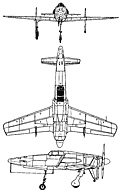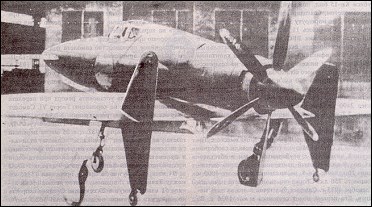|
| The first flight of the unique Kyushu J7W Shinden (magnificent lightning), a canard-configuration single-seat fighter, was made on 3 August 1945, but the end of World War II later that month brought an end to development and production plans. Designed by a team under the leadership of Captain Masaoki Tsuruno of the Imperial Japanese Navy, the configuration of this aircraft had been
effectively confirmed by the flight testing of three specially designed and built MXY6 gliders. The construction of two J7W1 prototypes followed, these each having a slender fuselage and mounting in a mid-position on the nose a short-span foreplane incorporating elevators at the trailing edge. The rear-mounted cantilever monoplane wing was set low on the fuselage, had moderately swept leading edges and conventional ailerons with, just inboard of these on each wing, a fin and rudder extending above and below the trailing edge. The landing gear was of retractable tricycle type; the pilot was accommodated in an enclosed cockpit, directly above the leading edge of the wing; and power was provided by a 1588kW Mitsubishi MK9D radial engine, mounted in the rear fuselage to drive a six-blade pusher propeller. By the end of the war the second prototype had been completed but not flown.
The J7W1 spanned 11.11m, had a maximum take-off weight of 5288kg, and was estimated to have a maximum speed of 750km/h. Armament was four nose-mounted 30mm Type 5 cannon. In the planning stage was the J7W2 version to be powered by a 900kg thrust Ne-130 turbojet.

| MODEL | J7W1 |
| CREW | 1 |
| ENGINE | 1 x Mitsubishi Ha-43, 1600kW |
| WEIGHTS |
| Take-off weight | 4928 kg | 10864 lb |
| Empty weight | 3645 kg | 8036 lb |
| DIMENSIONS |
| Wingspan | 11.1 m | 36 ft 5 in |
| Length | 9.66 m | 32 ft 8 in |
| Height | 3.92 m | 13 ft 10 in |
| Wing area | 20.5 m2 | 220.66 sq ft |
| PERFORMANCE |
| Max. speed | 750 km/h | 466 mph |
| Cruise speed | 420 km/h | 261 mph |
| Ceiling | 12000 m | 39350 ft |
| Range | 850 km | 528 miles |
| ARMAMENT | 4 x 30mm cannons |
 | A three-view drawing (752 x 1204) |
| RB, e-mail, 26.10.2020 08:52 Many were the canard experimental fighters of WW2, but this was the only one ordered to be produced.
Was jet power planned ? yes.
Was a bubble canopy planned? Yes.
Did it retain spent cases after firing to help with 'cg'? Yes.
Did it have the best 30mm cannon in WW2? I think so. The Navy 30mm Type 5 was the most reliable cannon in Japan. What 30mm cannon had heavier shells?
One post says The 350g HET ammo had 910m /s M /V! That should give it first shot advantage vs B-29s [if the 345g HE shell with 710m /s M /V, had 900m range]. I estimate 1,150m range for the HET.
Cycle rate was 435 to 500 /min. A few sources say the J7W would pack 66 r /g instead of 60. The bottom pair could be fired independently so that fire-time could be doubled to maybe 16 seconds. Even then, a one second salvo could still KO anything flying.
33 r /s fire pattern [with all 4 cannons] was dense enough to dogfight P-47N escorts too.
The famous Mk 108 of similar weight and faster rate had only 300 to 400m range, leaving aside reliability. Suicidal vs B-29s in comparison! reply | | Bubba, e-mail, 02.11.2015 17:40 The reports were it had instability in lateral plane and the engine had major cooling problems. It was nowhere near a production plane. As for performance at altitude is still had no decent turbocharger (severe lack of high temp materials). reply | | Bubba, e-mail, 02.11.2015 17:40 The reports were it had instability in lateral plane and the engine had major cooling problems. It was nowhere near a production plane. As for performance at altitude is still had no decent turbocharger (severe lack of high temp materials). reply | | Ron, e-mail, 10.10.2014 03:18 I like this one best of all the canard WW 2 era designs.
This was intended to be turbojet powered all along but prop would do, temporarily. So it overheated, vibrated, had strong torque pull, and long undercarriage. Not so the J7W3 jet version (which never flew)! reply | |
| | Barry, 16.08.2012 16:13 Lets put the pilot ejection problem to bed. The first plane to feature ejection seats was the Heinkel He219 Uhu, and yes the Dornier 335 did also have an ejection system. By the time that the Shiden was being developed the quantity and the quality of pilots was at a very low level and I think one will find that some very inexperienced recruits were selected for "kamakazi" operations more experienced pilots were required to fight and defend the homeland. Hence, even the Japanese would have installed some sort of pilot recovery system be it exploding propellor blades or a rudimentary ejection seat. reply | | Jim, e-mail, 17.12.2011 05:18 Does anybody know what city the Kyushu airplane factory was located on Kyoshu Island ? reply | | huawuke, 18.06.2011 09:41 It was fast and agile, had it appeared before the war was over, it would have been a huge threat against allied fighters and bombers. reply | | reppu, e-mail, 09.06.2011 16:46 To all wondering about pilot ejection, the Shinden DID have that covered: there was a small charge located on the tail which blew off the propeller before ejection.
What was more of an issue was the spent ammo casings. A problem unique to the Shinden was that you can't just throw them out, instead they had to be contained within the plane, which was at best, a waste of space and at worst, a jamming problem waiting to happen. reply |
| Thamer, e-mail, 28.05.2011 18:02 Sorry! My mistake... You are completely right. Was the Shiden KAI...not SHINDEN.... reply |
| y.k, e-mail, 28.05.2011 05:44 Saburo Sakai fought with Shiden(N1K2-J),not Shinden(J7W).
Too confusing. reply | | Thamer (from Brasil), e-mail, 27.05.2011 20:37 Saburo Sakai, great japanese ace, says in your book "SAMURAI", about himself in WWII, the Shinden was fight really in march, 19 of 1945 in battle involving this airplane and american Hellcat's. More than 40 airplanes Shinden was involving in this fight.... (excuse my errors in writing: I don't know the english language...) reply |
| Klaatu, e-mail, 29.04.2011 22:34 Several countries experimented with fighters in this configuration, including Sweden, Italy and the United States. It has one major drawback: how does the pilot get out in the event of an emergency? If he Bailed out he'd get pureed the propeller. There were no ejector seats yet. The first such seat was invented by the Germans at just about that time, for use in the Dornier Do335. reply | | Jonathan Glenister, e-mail, 11.01.2011 08:24 This is the aircraft that gave Burt and Dick Rutan the inspiration to build some their amazing aircraft as their father first saw this aircraft as an officer in the occupying forces in Japan at the end of WW2. reply |
| Mike Conatser, e-mail, 29.09.2010 02:37 If i remember correctly, they were testing it with a prop to see how it would handle. this plane was designed to fly with a jet engine. reply | |
| | Jackie, 08.08.2010 05:03 The Kyushu J7W Shinden was meant to be used in raids against the high flying B-29 Superfortresses. It was fast and agile, had it appeared before the war was over, it would have been a huge threat against allied fighters and bombers. reply | | Scott Lockhart, e-mail, 29.05.2010 18:12 Hasegawa has a 1 /48th scale model of the Shinden available through most online hobby shops. A limited run, 1 /32nd scale model is available from Zoukei-Mura, Inc. More information is available on their web site. The Zoukei-Mura model will also have options for the jet engine version. www.zoukeimura.co.jp /en /index.html reply | | trax, e-mail, 25.03.2010 19:27 This plane looks well designed, Looks Like They were ahead of time! Would love to have a Model of this Plane!! reply | | Rail Baron, e-mail, 09.03.2010 15:54 I would like a set of plans for this aircraft in 80 inch wingspan for use with a G-38 gas /oil engine. Then, could put video camera and transmitter in cockpit for pilot's eye view. reply | | Scott Williams, e-mail, 22.01.2010 18:47 There are plans available for the Shinden from R /C Modeller magazine. Plans are by Col. Robert Thacker. Scaled to a 60" wingspan, the only problems I found were his somewhat unorthodox construction methods, and his cg location was much too far aft. The plans should still be available via the R /C Modeller magazine website. It's designed for glow engine, mods to electric would involve significant restructuring for weight savings. reply | | Klaatu83, e-mail, 18.01.2010 00:37 A lot of people seem to think this was a pretty good design, very innovative and all that. However, it simply makes me wonder how the pilot was supposed to get out in the event of an emergency without getting sliced into sushi by the propeller. Then again, Japanese fighter pilots were supposed to be happy to die for their Emperor, so I don't suppose the designer ever gave the matter much thought. reply |
|
Do you have any comments?
|
| 
All the World's Rotorcraft |








 Thamer
Thamer
20
reply